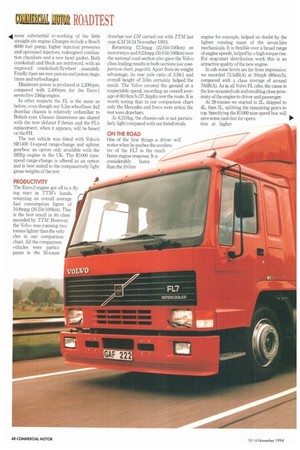212 ROADTEST
Page 50

If you've noticed an error in this article please click here to report it so we can fix it.
some substantial re-working of the little straight-six engine. Changes include a Bosch 8000 fuel pump, higher injection pressures and optimised injectors, redesigned combustion chambers and a new head gasket. Both crankshaft and block are reinforced, with an improved crankshaft/flywheel assembly Finally there are new pistons and piston rings, liners and turbocharger.
Maximum power is produced at 2,200rpm, compared with 2,400rpm for the Euro-1 seven-litre 256hp engine.
In other respects the FL is the same as before, even though our 52m-wheelbase 4x2 drawbar chassis is relatively unfamiliar to British eyes. Chassis dimensions are shared with the now defunct F-Series and the FL's replacement, when it appears, will be based on the FH.
The test vehicle was fitted with Volvo's SR1400 14-speed range-change and splitter gearbox: an option only available with the 282hp engine in the UK. The R1000 ninespeed range-change is offered as an option and is best suited to the comparatively light gross weights of the test.
PRODUCTIVITY
The Euro-2 engine got off to a flying start in TTM's hands, returning an overall average fuel consumption figure of 10.8mpg (26.11it/100km). This is the best result in its class recorded by T7'M. However, the Volvo was running two tonnes lighter than the vehicles in our comparison chart. All the comparison vehicles were participants in the 30-tonne drawbar test CM carried out with TTM last year (CM18-24 November 1993).
Returning 12.5mpg (22.61it/100km) on motorways and 9.23mpg (30.6 liV100km) over the national road section also gave the Volvo class leading results in both sections (see comparison chart, page50). Apart from its weight advantage, its rear axle ratio of 3.56:1 and overall height of 3.6m certainly helped the result. The Volvo covered the ground at a respectable speed, recording an overall average of 60.0km/h (37.3mph) over the route. It is worth noting that in our comparison chart only the Mercedes and Iveco were artics; the rest were drawbars.
At 6,310kg, the chassis-cab is not particularly light compared with our listed rivals. engine for example, helped no doubt by the lighter rotating mass of the seven-litre mechanicals. It is flexible over a broad range of engine speeds, helped by a high torque rise. For stop/start distribution work this is an attractive quality of the new engine.
In cab noise levels are far from impressive: we recorded 72.5dB(A) at 50mph (80km/h), compared with a class average of around 70dB(A). As in all Volvo FL cabs, the cause is the low-mounted cab and resulting close proximity of the engine to driver and passenger.
At 28-tonnes we started in 2L, skipped to 4L, then 5L, splitting the remaining gears to top. Specifying the R1000 nine-speed box will save some cash but for operation at higher








































































































